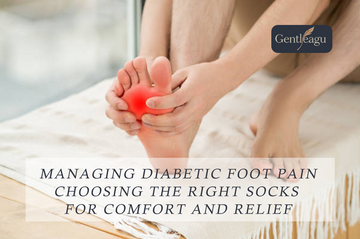Managing Diabetic Foot Pain: Choosing the Right Socks for Comfort and Relief
Foot pain is a common concern for individuals with diabetes, as the condition can lead to nerve damage (neuropathy), poor circulation, and an increased risk of infections. Wearing the right socks is a simple yet effective way to manage discomfort, reduce irritation, and support overall foot health. This guide highlights the importance of proper sock choices for diabetic foot care and provides practical tips on finding socks that offer relief and comfort.
Why Foot Care is Crucial for People with Diabetes
Diabetes can cause a range of foot-related issues, including:
- Neuropathy: Nerve damage that reduces the ability to feel pain, heat, or cold, increasing the risk of unnoticed injuries.
- Poor Circulation: Reduced blood flow slows healing and raises the risk of infection.
- Sores, Blisters, and Calluses: These can worsen if untreated, potentially leading to serious complications.
Proper foot care, including wearing the right socks, can help prevent these problems and protect sensitive feet.
How the Right Socks Help Relieve Diabetic Foot Pain
The right socks can address many of the challenges faced by people with diabetes:
- Improve Circulation: Socks with gentle compression support blood flow.
- Prevent Blisters and Sores: Designed to reduce friction and pressure, diabetic socks help protect the skin.
- Keep Feet Dry: Moisture-wicking materials prevent fungal infections and keep feet comfortable.
- Provide Cushioning: Extra padding relieves pressure and reduces discomfort.
What to Look for in Socks for Diabetic Foot Care
1. Seamless Construction
- Why It’s Important: Seams can create friction, causing irritation or blisters. Seamless socks reduce pressure on sensitive skin.
-
What to Look For:
- Socks with no toe seams.
- Seamless bamboo socks, which offer smooth, irritation-free wear.
2. Moisture-Wicking Properties
- Why It’s Important: Keeping feet dry prevents fungal infections and skin breakdown, common in diabetic feet.
-
What to Look For:
- Bamboo socks, known for their excellent breathability and moisture-wicking abilities.
- Cotton-blend socks with moisture-control features.
3. Non-Binding Tops
- Why It’s Important: Tight elastic can restrict blood flow, especially for those with poor circulation. Non-binding socks fit comfortably without digging into the skin.
-
What to Look For:
- Socks with a loose, stretchy top band.
- Non-binding bamboo socks for a secure but gentle fit.
4. Cushioned Padding
- Why It’s Important: Extra padding reduces pressure on high-stress areas like the heel and ball of the foot, helping to prevent ulcers and calluses.
-
What to Look For:
- Cushioned soles for enhanced comfort.
- Bamboo socks with added padding for sensitive feet.
5. Antibacterial and Antifungal Properties
- Why It’s Important: Diabetic feet are prone to infections due to reduced immunity. Antibacterial socks help prevent issues like athlete’s foot.
-
What to Look For:
- Bamboo socks, which naturally resist bacteria and fungi.
- Socks with antimicrobial technology for extra protection.
6. Gentle Compression
- Why It’s Important: Mild compression can improve circulation, reduce swelling, and prevent blood clots in individuals with poor blood flow.
-
What to Look For:
- Socks specifically designed for diabetic care with light compression.
- Bamboo compression socks for added comfort and warmth.
Socks for Specific Diabetic Foot Issues
- For Neuropathy (Nerve Damage): Opt for soft, seamless socks to minimize friction and irritation. Bamboo socks are particularly gentle.
- For Swollen Feet (Edema): Choose non-binding or mild compression socks to reduce swelling without restricting blood flow.
- For Foot Ulcers and Calluses: Cushioned socks provide extra protection and reduce pressure on sensitive areas.
Best Socks for Diabetic Foot Care
-
GENTLEAGU Bamboo Socks:
- Moisture-wicking and breathable for all-day comfort.
- Antibacterial and hypoallergenic properties for healthier feet.
- Seamless design and cushioned soles to reduce irritation and pressure.
Popular Options:
- Thin Bamboo Ankle Socks: Ideal for daily wear and minimizing foot irritation.
- Cushioned Bamboo Crew Socks: Provide extra padding and comfort for extended use.
Conclusion: Prioritizing Comfort and Foot Health
Choosing the right socks is an essential step in managing diabetic foot pain and preventing complications. Look for seamless, moisture-wicking, cushioned, and non-binding socks made from breathable materials like bamboo. These features help keep feet dry, comfortable, and protected while supporting healthy circulation.
For an eco-friendly and effective solution, GENTLEAGU Bamboo Socks are an excellent choice, offering softness, durability, and added foot protection. Invest in the right socks to prioritize your foot health and enjoy greater comfort every day.
